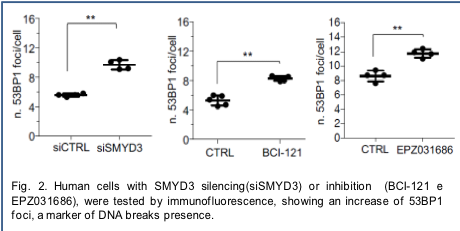Analyses of physical and functional relation between SMYD3 methyltransferase and BRCA1/2 in the context of DNA breaks repair.
SMYD3 is a methyl transferase overexpressed in several tumors and it has been found involved in typical cancer cell phenomena such as cell proliferation and migration. SMYD3 targets both histones and non-histone proteins.
As part of a large multi-center project on the role of SMYD3 in breast cancer, we have carried out preliminary studies to evaluate a possible involvement of this protein in the cellular response to the presence of DNA double strand breaks. We tested the possible accumulation of these lesions in breast cancer cells with depleted or inhibited SMYD3 and we highlighted, by immunofluorescence, an accumulation, respect to control, of 53BP1 foci, a marker of DNA breaks with a key role in the choice of the repair system (Fig. 2).

Since it is unknown whether this effect depends on the methyltransferase activity of SMYD3 on histone or non-histone proteins, we will evaluate whether SMYD3 methylates histones or other components of the response to DNA damage nearby the lesion and how this could influence the choice of the repair system. SMYD3 has previously been reported to modulate breast cancer risk in both women and men harbouring BRCA1/2 mutations. Since BRCA proteins are known to play a very important role in DNA repair by Homologous Recombination, we will explore possible physical and functional relationships between SMYD3 and BRCA1/2 in the context of DNA damage. SMYD3 will be also mutated, depleted or overexpressed in cells derived from female and male breast cancer to test the effect on the maintenance of genome stability. Finally, we will evaluate the possibility that a co-treatment with SMYD3 inhibitors may favor the activity of some chemotherapeutics drugs in the treatment of BRCA1/2 negative breast cancer.
